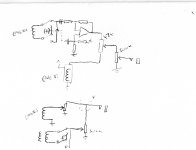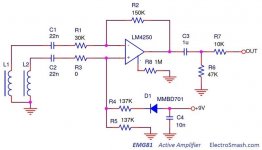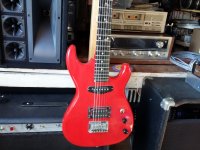Hi guys,
I'm re-wiring an old strat copy with 1 bridge humbucker and a slanted single coil in the neck. The single coil is passive, im not sure on using an active or passive humbucker. if i use an EMG81, I'll want a preamp on the EMGSES. I want to be able to blend the 2 pickups with a phase switch on one of them. Ive attached the ideas i came up with but im not sure on,
A) For a preamp on the single coil, should it have a ground connection, or would connecting it to the + on a differential op amp be enough? (i found an EMG81 diagram to go by, is the ground on the center tap necessary?)
B) What would be the best way to do this, and has anyone seen anything similar?
I'm re-wiring an old strat copy with 1 bridge humbucker and a slanted single coil in the neck. The single coil is passive, im not sure on using an active or passive humbucker. if i use an EMG81, I'll want a preamp on the EMGSES. I want to be able to blend the 2 pickups with a phase switch on one of them. Ive attached the ideas i came up with but im not sure on,
A) For a preamp on the single coil, should it have a ground connection, or would connecting it to the + on a differential op amp be enough? (i found an EMG81 diagram to go by, is the ground on the center tap necessary?)
B) What would be the best way to do this, and has anyone seen anything similar?
Attachments
Hey,
Long time lurker, first post here.
You should be able to find diagrams in the drop down menus at Seymour Duncan's wiring site. You'll have to cobble together 2 diagrams into a circuit that suits your end-use-application, but the info is there and hopefully the answer to your question.
Wiring Diagrams - Seymour Duncan
Personally, I prefer passive inside my guitars, as I like to get preamps out of instruments and into stomp-box or hammond enclosures for a number of reasons, then I can also use the preamp across all guitars. I use an 2 X OPA2132 buffer preamp in a stomp box enclosure to achieve magnetic and piezo pickup impedance matching and up to +3dB gain. I can blend at will and the buffer is great.
Not sure how helpful this is, but the SD wiring diagrams are a great resource.
Cheers.
Long time lurker, first post here.
You should be able to find diagrams in the drop down menus at Seymour Duncan's wiring site. You'll have to cobble together 2 diagrams into a circuit that suits your end-use-application, but the info is there and hopefully the answer to your question.
Wiring Diagrams - Seymour Duncan
Personally, I prefer passive inside my guitars, as I like to get preamps out of instruments and into stomp-box or hammond enclosures for a number of reasons, then I can also use the preamp across all guitars. I use an 2 X OPA2132 buffer preamp in a stomp box enclosure to achieve magnetic and piezo pickup impedance matching and up to +3dB gain. I can blend at will and the buffer is great.
Not sure how helpful this is, but the SD wiring diagrams are a great resource.
Cheers.
Hey,
Long time lurker, first post here.
You should be able to find diagrams in the drop down menus at Seymour Duncan's wiring site. You'll have to cobble together 2 diagrams into a circuit that suits your end-use-application, but the info is there and hopefully the answer to your question.
Wiring Diagrams - Seymour Duncan
Personally, I prefer passive inside my guitars, as I like to get preamps out of instruments and into stomp-box or hammond enclosures for a number of reasons, then I can also use the preamp across all guitars. I use an 2 X OPA2132 buffer preamp in a stomp box enclosure to achieve magnetic and piezo pickup impedance matching and up to +3dB gain. I can blend at will and the buffer is great.
Not sure how helpful this is, but the SD wiring diagrams are a great resource.
Cheers.
Yes they certainly were, but we are 24hours too late. They have just changed their site and most of the diagrams are gone except for the very plain ones.
Wiring Diagrams - Seymour Duncan | Seymour Duncan
Thanks, but not quite what i was looking for.
For anyone interested i went with design 1, but with a passive single coil (disguised as a humbucker) in the bridge, EMG ses in the neck, both with an ne5532p preamp. i put the phase switch on the humbucker. the blend control can act like a crude wah and can get quite a range of sounds, from metal to funk.
For anyone interested i went with design 1, but with a passive single coil (disguised as a humbucker) in the bridge, EMG ses in the neck, both with an ne5532p preamp. i put the phase switch on the humbucker. the blend control can act like a crude wah and can get quite a range of sounds, from metal to funk.
Sounds like a good setup. I was wondering how you were gonna wire them together when only one was preamp'd.... amping both (with different gain settings I presume) keeps impedances much more matched. Pic below is a cheapo (but nice playing) axe that I added a single coil to, and a Les Paul switch (I call it the Fender/Gibson switch).
It's like having two guitars in one! Have fun.
It's like having two guitars in one! Have fun.
Attachments
A pre amp in the guitar is a good idea.
It saves on losses from high impedance pickup into a long capacitive cable.
You should get a bit more top end.
I have seen a few guitar internal pre amp circuits in electronics magazines over the years.
Certainly true. For these reasons I stuffed my strat with a simple JFET-source-follower that feeds a 22kLog vol pot. Same level as a passive wiring, but no more probs with long, hi capacitance guitar cables, and no treble loss when reducing volume.
Those jfet source follower circuits can work remarkably well. The key thing is to bias the jfet to get the source voltage up high enough (just over half the supply is ideal), and to use a source resistor of a value that gives a good balance between low current consumption, and output drive capability. This one works well with a 2N5457 or a J201, and it will push a hot guitar signal into a mixer Line-in if needed.

Power can be connected using the ring terminal of a TRS jack. Added enhancements to it can be to feed the power through a few hundred ohms, followed by a 10uF cap to ground. Also, in theory, there is a bit less noise generated if the bias voltage is provided by a pair of 100k resistors as a voltage divider, a cap to ground then feed the source from that via a 1M resistor. But I have not noticed any noise issue at all from the simpler version above.
But in a guitar, one can go simpler still:

This one has no input cap or bias resistors and the gate is biased to ground via the guitar circuitry. It needs a jfet with a highish Vgs so the source will float up to a few volts. An MPF102 worked for mine. This was powered by two x3V lithium cells in a holder stuck to a pot back. The output components were fine for feeding into a guitar amp and driving long cables, and it worked well into a mixer too though in theory a bit more current drive would have been preferable. But it was just 4 components mounted on the jack!

Power can be connected using the ring terminal of a TRS jack. Added enhancements to it can be to feed the power through a few hundred ohms, followed by a 10uF cap to ground. Also, in theory, there is a bit less noise generated if the bias voltage is provided by a pair of 100k resistors as a voltage divider, a cap to ground then feed the source from that via a 1M resistor. But I have not noticed any noise issue at all from the simpler version above.
But in a guitar, one can go simpler still:

This one has no input cap or bias resistors and the gate is biased to ground via the guitar circuitry. It needs a jfet with a highish Vgs so the source will float up to a few volts. An MPF102 worked for mine. This was powered by two x3V lithium cells in a holder stuck to a pot back. The output components were fine for feeding into a guitar amp and driving long cables, and it worked well into a mixer too though in theory a bit more current drive would have been preferable. But it was just 4 components mounted on the jack!
- Status
- This old topic is closed. If you want to reopen this topic, contact a moderator using the "Report Post" button.
- Home
- Live Sound
- Instruments and Amps
- Guitar Pickup Wiring


